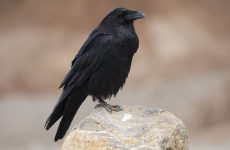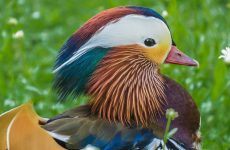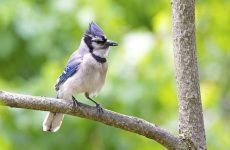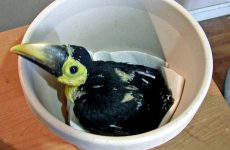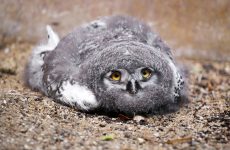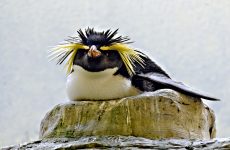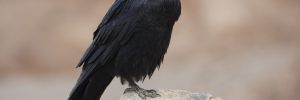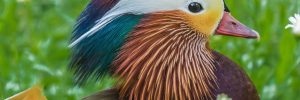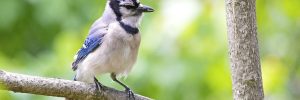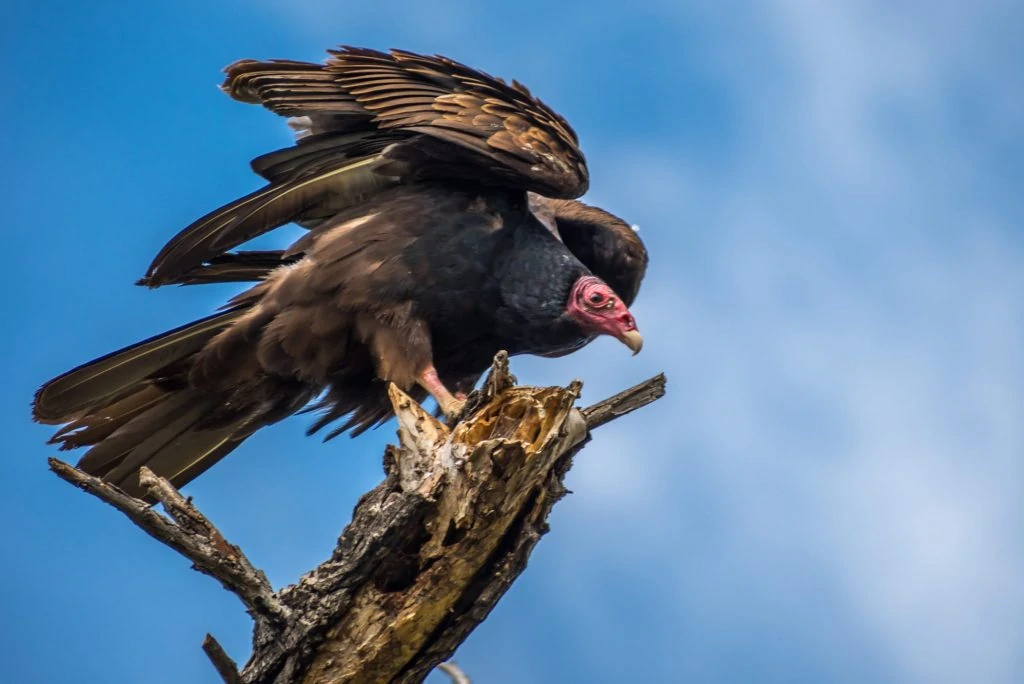
Vultures have some disgusting habits such as urinating on themselves to keep cool, only eating bacteria-laden dead animals which they stick their bald heads into to tear the flesh, and vomiting to escape from predators.
However, these disgusting habits are in fact brilliant adaptations that help the vultures to survive and clean up the environment for us.
Vultures are often perceived as birds of ill-omen because they are often seen hanging around dying animals and feeding on their carcasses.
Here are some of the fun, interesting, and even disgusting facts about vultures.
1. Vultures Urinate On Themselves
Vultures are known to urinate on themselves in a process called urohydrosis. When vultures are stressed because of the heat, they pee on their legs and feet in order to cool their temperatures down through evaporative cooling.
When the pee evaporates, the vulture starts to feel cool. It’s like how sweat works for humans!
2. Vulture Pee Acts As A Disinfectant For Bacteria
So, when vultures pee on their legs and feet, it has another purpose aside from cooling them off. The acid in the pee actually has the capability to kill the bacteria on their feet which they often accumulate from wading in carcasses when they eat.
3. Vultures’ Bald Heads Stop Their Feathers From Getting Congealed With Blood And Stop Them Overheating
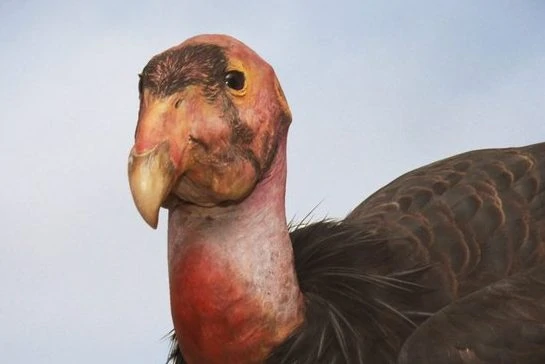
Why are vultures bald? One possible reason is that when vultures eat, they go for the juiciest parts of an animal and that means, they will have to get inside the carcasses and get their heads bloody as a result.
If they had feathers, that would be quite a feat to clean themselves up. It was thought that having bald heads made it easy for vultures to clean up after feeding.
But the real reason is pretty simple. Their bald heads aid in their thermoregulation. Researchers found that exposing their bald heads including their necks during the hottest temperatures allows them to cool down faster.
And during the colder temperatures, keeping their bald heads tucked in decreases the heat lost and allows them to stay warm longer.
4. Vultures Vomit To Escape Enemies
Vultures’ defensive mechanism when threatened is unique. They will vomit in order to evade their enemies. One possible reason for vomiting is that it makes them lighter in terms of weight.
When vultures have thrown up the food that is in their “crops” or pouches in their throats, they may be able to be lighter on their feet making escape easier to accomplish.
Their vomit may also serve as a decoy against other predators. When the predators are distracted by the vomit, the vultures can hastily make their escape. Also, their vomit is extremely foul-smelling and acidic enough to burn their enemies. So, it’s technically a win-win for the vultures.
5. Vultures Lack Vocal Organs To Make Songs
Vultures may be large birds but they don’t sing because they do not have a syrinx or a voicebox. They do have the ability to make deep hisses or grunts, and bill clacks especially when alarmed or jostling for a space at a carcass.
6. Vultures Can Weigh As Much As 15 Kilos
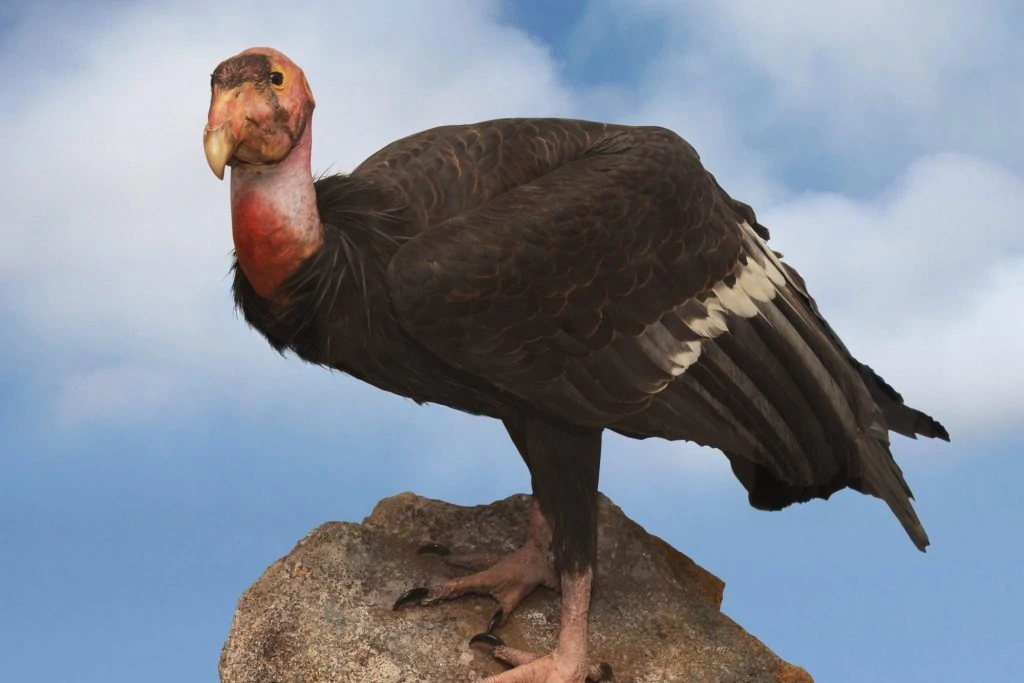
There are three species of vultures that have masses of over 10 kilos. The Andean Condor is the heaviest at 15 kilos (33 lbs). The Cinereous vulture comes in second weighing 14 kilos (30 lbs.) The California Condor weighs as much as 11 kilos (25 lbs).
7. Vultures Have A Wingspan Of Up To 2m
Vultures are very large birds and are actually one of the largest birds in North America. While wingspan measurements may vary among vultures, on average, they can reach up to 2 meters (72 inches) or roughly the length of a 6-foot man.
8. Ranges Of Vultures Can Be Thousands Of Kilometers
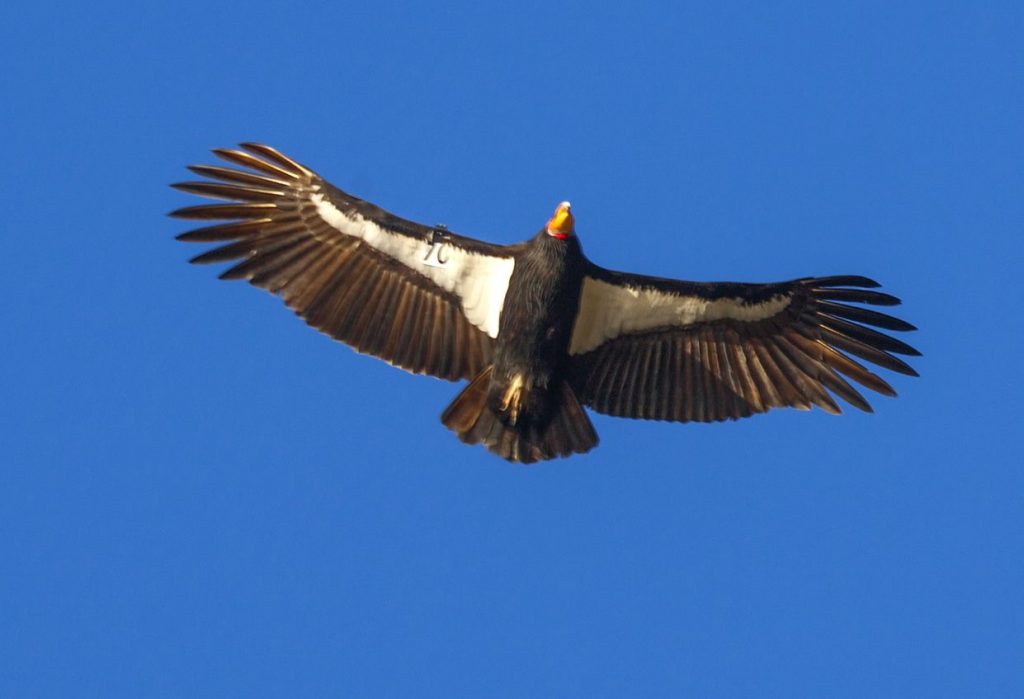
Vultures with their large wingspans can cover huge areas in search of food. Some of them, especially those in the colder regions like Canada migrate to South America, covering a potential distance of almost 10,000 kilometers or more than 5,000 miles.
A study on breeding ranges of Turkey Vultures showed their movement within 49 to 1,992 square kilometers.
Another study on endangered vultures in Africa showed that “adult white-backed vultures have average home ranges of about 24,000 km² in east Africa and 31,500 km² in southern Africa. Cape Vultures and Rüppell’s vultures soar over even larger areas, averaging 36,000 km² and 75,000 km², respectively”.
9. Vultures Eat Dead Animals
Vultures are commonly portrayed in movies circling a dying animal and feeding on its dead body. They have an amazing sense of smell that allows them to detect the gases that a dead body releases.
Together with their exceptional sense of sight, they are able to pinpoint the exact location of the carcass.
10. Vultures’ Stomach Acid Is Pretty Powerful Stuff
If you think about it, how can vultures eat rotting flesh? Vultures’ stomach acid is extremely strong (pH=1.0). It effectively kills viruses and bacteria from the dead carcasses and allows them to safely digest their meal.
11. Vultures Are Nature’s Clean-up Crew
There may be some “disgusting” habits that vultures are known for that give them a bad reputation.
However, can you imagine a world without scavengers like vultures?
Dead animal carcasses will litter forests, jungles, deserts, and other environments and spread diseases that may be detrimental to the health of humans. By eating these rotting, smelly, and disgusting dead bodies, vultures are effectively cleaning up our environment.
12. Vultures Need Other Savengers To Open Up Tough Hides
Vultures’ legs are weak and their talons are not strong enough to create holes in some animals’ thick hides so they need other scavengers, like hyenas, coyotes, and eagles, to do it for them. Once the tough hides are broken apart, they just use their powerful beaks to tear and rip through the meatier parts.
13. Vultures Will Not Eat A Carcass That Is A Few Days Old
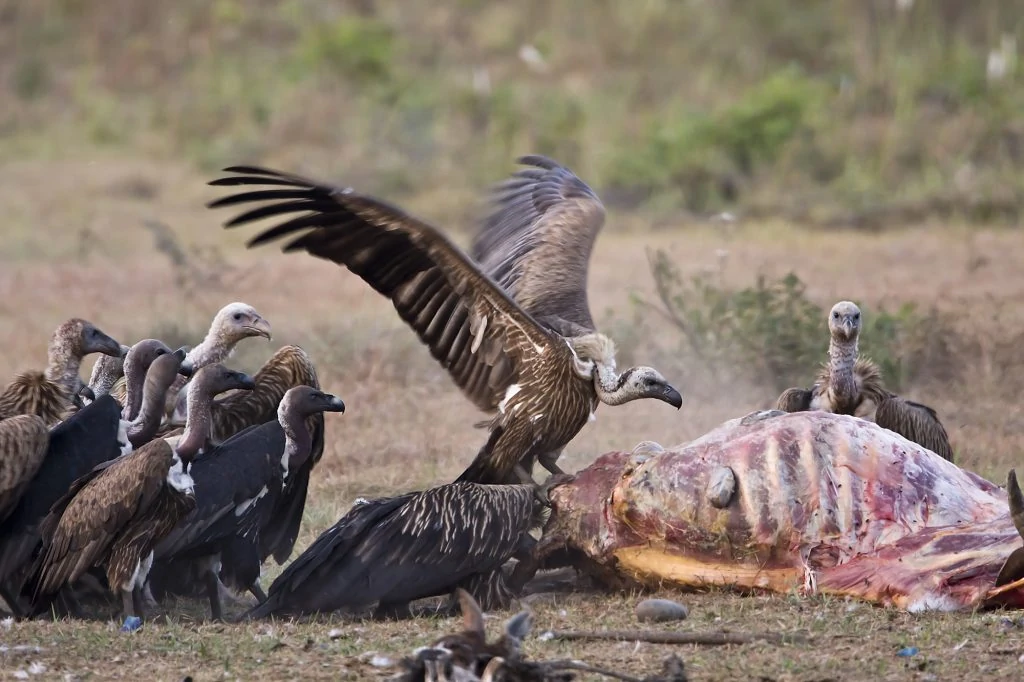
While vultures eat carrion, they will not eat a carcass that is a few days old simply because it has turned putrid or it is too rotten for their tastes.
14. Vultures Do Not Hunt
Vultures don’t usually kill or hunt for food. They will not confront a large, living animal. They are scavengers that wait patiently for a sick or unwell animal to simply die before they feed. They will occasionally kill small, helpless animals that pose no threat to them.
15. Vultures Don’t Build Nests
Nests of Vultures technically are non-existent since they don’t build them. They just lay their eggs on the ground in places like caves, abandoned buildings, and thickets. They may also put them inside hollow trees and tree stumps and re-use successful nesting sites for many years.
16. Vultures Only Lay between 1 and 3 Eggs
Female Black Vultures lay one to three eggs that both parents incubate for twenty-eight to forty-one days. Once they hatch, they are fed by their parents through regurgitation, meaning parents spit up food from their own stomachs and into the mouths of their babes. They nurture their young for as long as eight months.
They may only breed every two years and so they are at risk of declining in number with the added threat of habitat loss.
17. Vultures Use Thermals
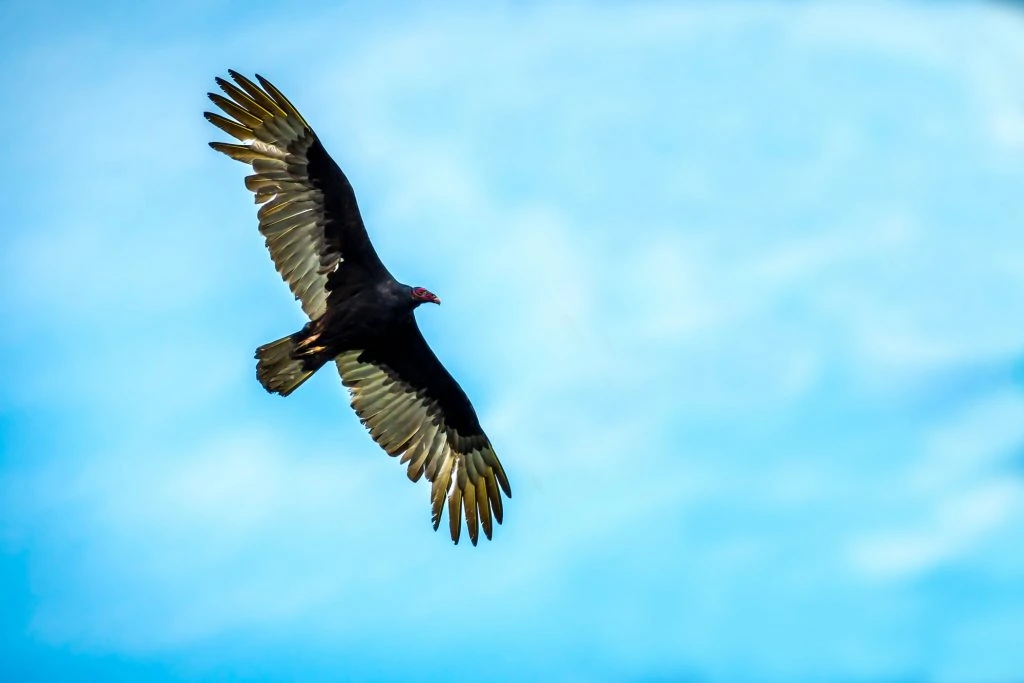
The California Condor normally uses thermals, or upward currents of warm air, to gain height and keep them soaring in the air.
18. Some Vultures Are Friendly And Create Communal Roosts
Black vultures form strong social bonds such that they have communal roosts and they share food among relatives. They’re extremely selective about non-relatives joining in the communal roosts and will attack those who will try.
19. There Are 23 Species Of Vultures In The World
There are two major groups of vultures in the world with a total of 23 species.
The Old World Vultures belong to the Accipitridae family with 16 species across Europe, Africa, and Asia. The New World Vultures belong to the Cathartidae family in North and South America and have a total of 7 species.
20. King Vultures Have Amazing Multi-colored Faces
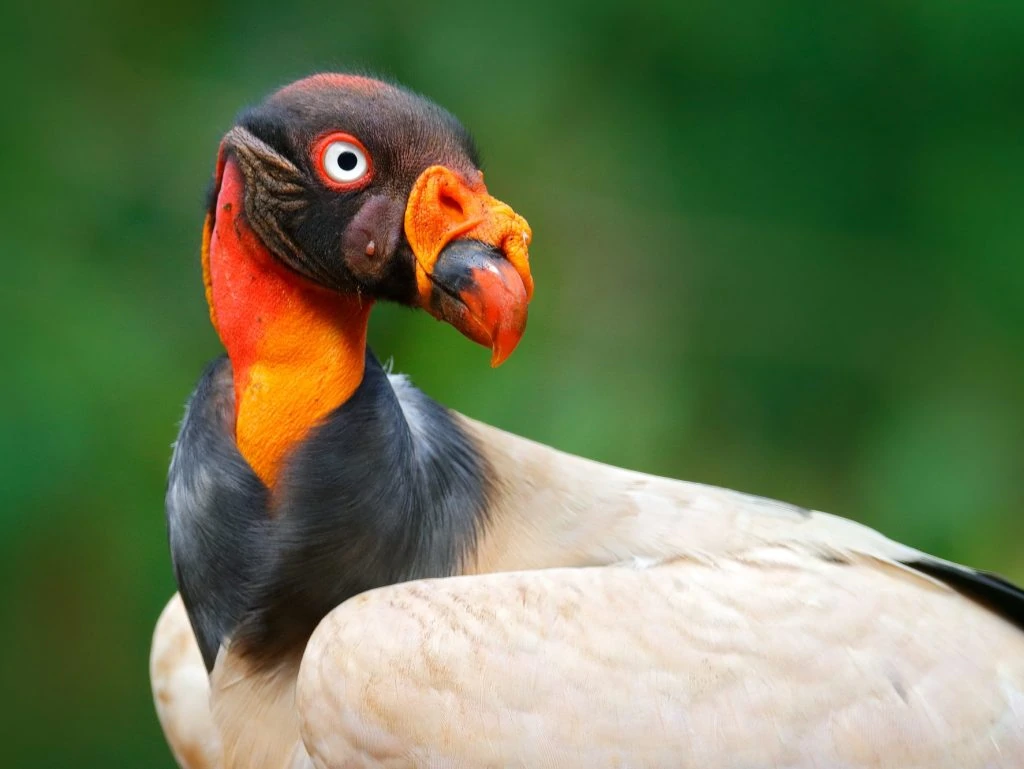
Of the twenty-three species of vultures in the world, King Vultures have the distinction of having an amazing multi-colored face. While some vultures have black, red, brown, white, or gray heads, King Vultures have several different colors on their heads.
Their facial skin has red and purple coloring. They have red eyerings. Their necks are bright orange and their throats are yellow. They have golden crests attached to their orange and black bills.
21. The Largest Vulture Is The Andean Condor
The Andean Condor of South America (Vultur gryphus) is considered the largest flying bird in the world, considering its weight and wingspan. Its maximum wingspan reaches 3.3 meters or about 11 feet.
It’s also heavy, with a weight of 15 kg (33 lbs). It also holds the title of being the largest bird of prey in the world.
22. The Smallest Vulture Is The Hooded Vulture
If the Andean Condor is the Largest Vulture, its counterpart the Smallest Vulture is the Hooded Vulture (Necrosyrtes monachus) of Africa. Measuring only 2 feet (62 cm) and weighing about 3 kg (6.6 lbs).
23. California Condors Have A Long Life Span
The exact lifespan of California Condors is unknown but is estimated to reach up to sixty years. The oldest California Condor, Topatopa, turned 50 years old in 2016. They were originally almost extinct despite this, but conservation efforts have proven successful, and now there are as many as 500 birds in the wild and in captivity.
24. The California Condor Is The Largest North American Land Bird.

It is a critically endangered species and was extinct in the wild in 1987. Today, after the success of conservation efforts starting with only 22 California Condos in captivity, there are now about 500 living individuals as of 2020.
25. Of The World’s Vultures Are Endangered
16 species of the world’s vultures are now on different levels of being endangered species from Near Threatened (NT), Vulnerable to Extinction (V), Endangered (E), or Critically-Endangered (CE).
Here are the world’s endangered vultures: Andean Condor(V), Cinereous Vulture (NT), Himalayan Griffon (NT), Bearded Vulture (NT), Lappet-Faced Vulture (E), Cape Vulture (E), Egyptian Vulture (E), White-headed Vulture (CE), White-backed Vulture (CE), Ruppell’s Vulture (CE), Hooded Vulture (CE), Indian Vulture (CE), Slender Billed Vulture (CE), Indian White-Rumped Vulture (CE), Red-Headed Vulture (CE), and the California Condor (CE).
The “Asian Vulture Crisis” of the late 1990s saw populations of three species of Gyps vulture collapse throughout South Asia, by >96% in just 10 years, due to incidental Diclofenac poisoning (Prakash 1999; Gilbert et al. 2002; Oaks et al. 2004).
The reasons why vultures are becoming extinct include poaching, poisoning, and habitat destruction.
26. An Extinct Vulture Had a Wingspan of 6.5m and weighed 72KG
The extinct vulture Argentavis magnificens had a wingspan of approximately 5m – 6.5m and a mass of around 70 – 72 kg. It was believed to have a wingspan of 7m and a mass of 80kg but more refined techniques have yielded more accurate measurements. It is still an impressive specimen.
27. Poison Is The Biggest Killer Of Vultures
Huge numbers of vultures are dying due to poisoning. Poachers use poison on carcasses to kill many vultures at once. Vultures are targeted for their meat and traditional medicinal purposes of their body parts.
They also die from secondary poisoning when the carcasses that they eat have been given medicinal drugs that are unfortunately toxic to the vultures.
28. A Group Of Vultures Is Called A Committee
A group of vultures in flight is called a ‘kettle’, while the term ‘committee’ refers to a group of vultures resting on the ground or in trees. A group of vultures that are feeding is termed a ‘wake’.[6]
Here is an example of a committee of Vultures in Central Florida Neighborhood

